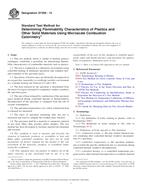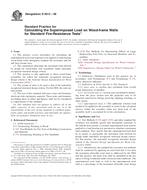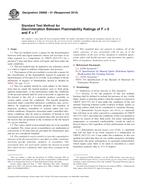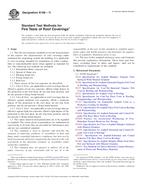Potrebujeme váš súhlas na využitie jednotlivých dát, aby sa vám okrem iného mohli ukazovať informácie týkajúce sa vašich záujmov. Súhlas udelíte kliknutím na tlačidlo „OK“.
ASTM D7309-13
Standard Test Method for Determining Flammability Characteristics of Plastics and Other Solid Materials Using Microscale Combustion Calorimetry
Automaticky preložený názov:
Štandardná skúšobná metóda pre stanovenie horľavosti Charakteristika plastov a iných pevných materiálov Použitie Microscale spaľovanie kalorimetria
NORMA vydaná dňa 1.11.2013
Informácie o norme:
Označenie normy: ASTM D7309-13
Poznámka: NEPLATNÁ
Dátum vydania normy: 1.11.2013
Kód tovaru: NS-38127
Počet strán: 11
Približná hmotnosť: 33 g (0.07 libier)
Krajina: Americká technická norma
Kategória: Technické normy ASTM
Kategórie - podobné normy:
Ohnivzdornost stavebních materiálů a prvků
Plastické hmoty obecně
Anotácia textu normy ASTM D7309-13 :
Keywords:
calorimetry, carbon dioxide, combustion, controlled heating, heat release, heat release rate, heat release capacity, oxidative thermal decomposition, oxygen consumption calorimetry, pyrolysis, thermal analysis, thermal decomposition, ICS Number Code 13.220.50 (Fire-resistance of building materials and elements), 83.080.01 (Plastics in general)
Doplňujúce informácie
| Significance and Use | ||||||||||||||
|
5.1 This laboratory test method measures thermal combustion properties of materials (1-5).3 5.2 The test uses controlled thermal decomposition of specimens and thermal oxidation of the specimen gases as they are released from the specimen to simulate the condensed and gas phase processes of flaming combustion, respectively, in a small-scale laboratory test (1-7). 5.3 The thermal combustion properties measured in the test are related to flammability characteristics of the material (4-7). 5.4 The amount of heat released in flaming combustion per unit mass of material is the fire load and the potential fire load (complete combustion) is estimated in Method A as hc. 5.5 The net calorific value of the material (see Test Method D5865) is determined directly using Method B as hco without the need to know the atomic composition of the specimen to correct for the latent heat of evaporation of the water produced by combustion, or to perform titrations to correct for the heat of solution of acid gases. See 5.6 The heat release temperature Tmax of Method A approximates the surface temperature at piloted ignition in accordance with Ref. (5-7) for purposes of fire modeling (See Guide E1591). 5.7 The heat release capacity ηc (J/g-K) is a flammability parameter measured in Method A that is unique to this test method. |
||||||||||||||
| 1. Scope | ||||||||||||||
|
1.1 This test method, which is similar to thermal analysis techniques, establishes a procedure for determining flammability characteristics of combustible materials such as plastics. 1.2 The test is conducted in a laboratory environment using controlled heating of milligram specimens and complete thermal oxidation of the specimen gases. 1.3 Specimens of known mass are thermally decomposed in an oxygen-free (anaerobic) or oxidizing (aerobic) environment at a constant heating rate between 0.2 and 2 K/s. 1.4 The heat released by the specimen is determined from the mass of oxygen consumed to completely oxidize (combust) the specimen gases. 1.5 The rate of heat released by combustion of the specimen gases produced during controlled thermal or thermoxidative decomposition of the specimen is computed from the rate of oxygen consumption. 1.6 The specimen temperatures over which combustion heat is released are measured. 1.7 The mass of specimen remaining after the test is measured and used to compute the residual mass fraction. 1.8 The specimen shall be a material or composite material in any form (fiber, film, powder, pellet, droplet). This test method has been developed to facilitate material development and research. 1.9 This standard is used to measure and describe the response of materials, products, or assemblies to heat and flame under controlled conditions, but does not by itself incorporate all factors required for fire hazard or fire risk assessment of the materials, products, or assemblies under actual fire conditions. 1.10 This standard does not purport to address all of the safety concerns, if any, associated with its use. It is the responsibility of the user of this standard to establish appropriate safety and health practices and determine the applicability of regulatory limitations prior to use.
|
|
Standard Practice for Conducting an Interlaboratory Study to Determine the Precision of a Test Method
|
|
Standard Guide for Obtaining Data for Fire Growth Models
|
|
Standard Practice for Use of the Terms Precision and Bias in ASTM Test Methods
|
|
Standard Terminology of Fire Standards
|
|
Standard Terminology Relating to Plastics
|
|
Standard Test Method for Temperature Calibration of Differential Scanning Calorimeters and Differential Thermal Analyzers
|
|
Standard Test Method for Gross Calorific Value of Coal and Coke |
Podobné normy:
Historická
1.2.2008
Historická
1.5.2010
Historická
1.9.2008
Historická
15.11.2011
Historická
15.1.2010
Historická
15.7.2012



 ASTM D6513-08
ASTM D6513-08 ASTM D6668-01(2010)..
ASTM D6668-01(2010).. ASTM D6841-08
ASTM D6841-08 ASTM D7746-11
ASTM D7746-11 ASTM E108-11
ASTM E108-11 ASTM E119-12a
ASTM E119-12a
 Cookies
Cookies
